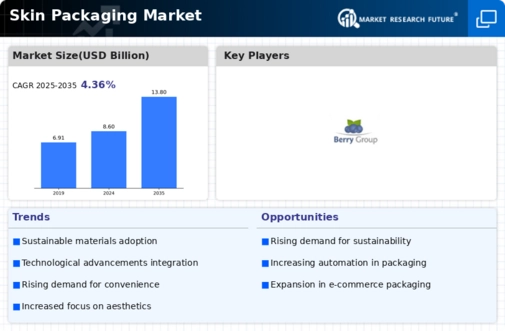Market Trends
Key Emerging Trends in the Skin Packaging Market
Skin packaging, a form of packaging where a thin plastic film is draped over a product and sealed to a backing board, has seen notable market trends in recent years, reflecting shifts in consumer preferences, technological advancements, and sustainability concerns. This packaging method is widely used in various industries, including food, electronics, and healthcare, due to its ability to provide product visibility, protection, and shelf appeal.
Some of the strict government rules concerning avoiding wastage while packaging and increasing the capability for rising the shelf life of skin packaging products steer up the skin packaging market size. The high rise in cost-effective packaging products that use less raw materials and resources is the other most important challenging factor.
One significant trend in the global skin packaging market is the increasing demand for sustainable and eco-friendly packaging solutions. With growing awareness of environmental issues and regulatory pressures to reduce plastic waste, there is a rising preference for packaging materials that are recyclable, biodegradable, or made from renewable sources. Manufacturers are responding to this trend by developing skin packaging solutions using environmentally friendly materials such as recycled plastics, bio-based films, and compostable materials. These sustainable options not only align with consumer preferences but also help companies meet their corporate sustainability goals and regulatory requirements.
Moreover, technological advancements have played a crucial role in shaping market trends in the skin packaging industry. Innovations in packaging machinery, materials, and printing technologies have led to the development of advanced skin packaging solutions with improved functionality, efficiency, and aesthetics. For instance, the adoption of modified atmosphere packaging (MAP) technology allows skin packaging to extend the shelf life of perishable products by creating a controlled atmosphere within the package, reducing food waste and enhancing product freshness. Additionally, advancements in printing techniques such as flexography and digital printing enable manufacturers to create visually appealing and informative skin packaging designs that enhance brand visibility and consumer engagement.
Additionally, the global skin packaging market is influenced by shifting consumer preferences and buying behavior, particularly in the food and retail sectors. With consumers seeking convenience, freshness, and visual appeal in packaged products, there is a growing demand for skin packaging solutions that offer clear product visibility, tamper resistance, and attractive branding. Skin packaging meets these requirements by securely encasing products in a transparent film that showcases the contents while providing protection against contamination and tampering. This trend is driving increased adoption of skin packaging by food manufacturers, retailers, and consumer goods companies looking to enhance product presentation and differentiate their offerings in the market.
Furthermore, market trends in the global skin packaging market are shaped by evolving regulatory landscapes and industry standards governing packaging and labeling practices. Regulatory bodies such as the Food and Drug Administration (FDA) in the United States and the European Food Safety Authority (EFSA) in Europe establish guidelines and requirements for food packaging materials, safety, and labeling. Compliance with these regulations drives the adoption of skin packaging materials and designs that meet specific criteria for food contact safety, labeling information, and packaging integrity, ensuring consumer safety and regulatory compliance.





Leave a Comment